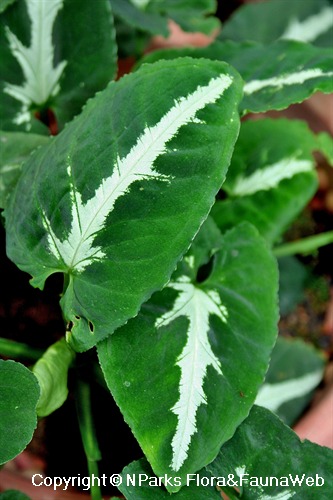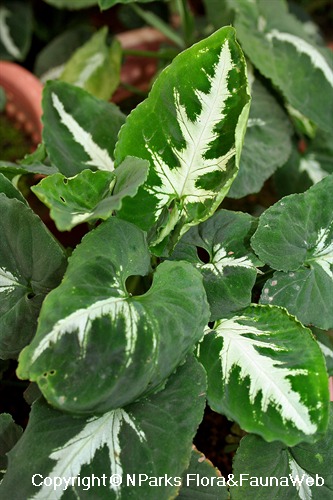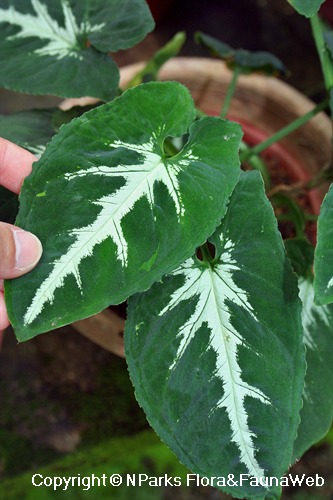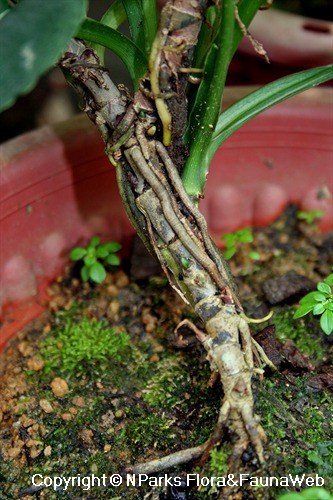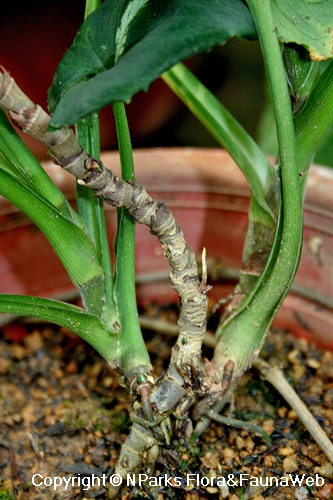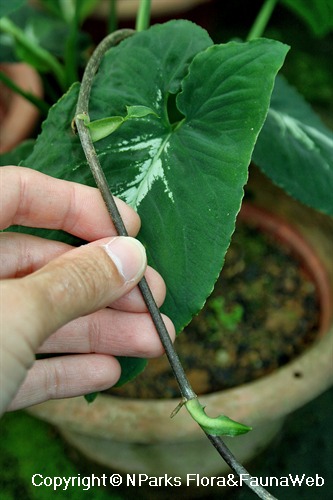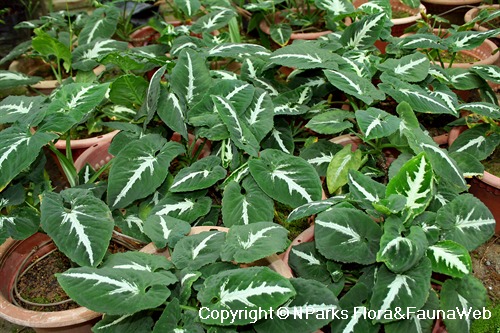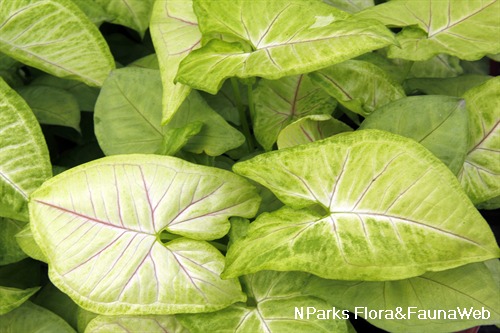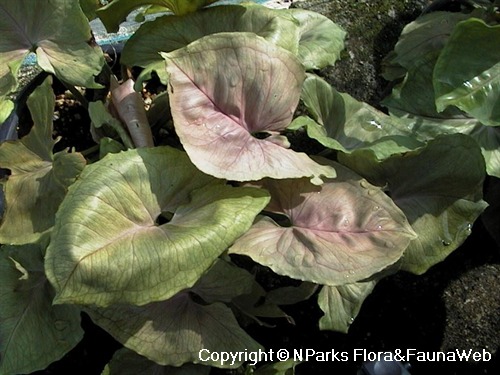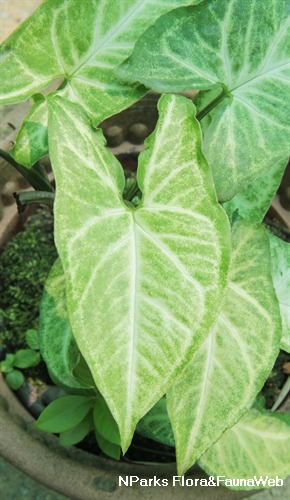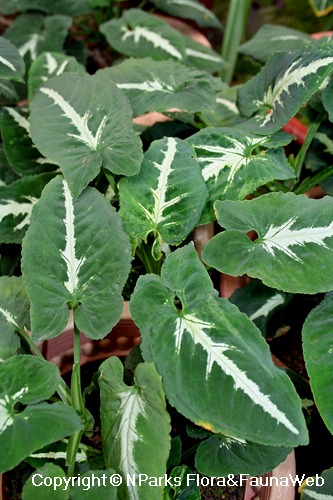
Back
Syngonium wendlandii Schott
| Family Name: | Araceae |
| Common Name: | Silver Goosefoot Plant, Velvety Syngonium, 绒叶合果芋 |
Name
Classifications and Characteristics
| Plant Division | Angiosperms (Flowering Seed Plants) (Monocotyledon) |
|---|---|
| Plant Growth Form | Climber, Herbaceous Plant |
| Lifespan (in Singapore) | Perennial |
| Mode of Nutrition | Autotrophic |
| Plant Shape | Shrubby |
| Maximum Height | 0.5 m to 0.6 m |
Biogeography
| Native Distribution | Costa Rica |
|---|---|
| Preferred Climate Zone | Tropical |
Description and Ethnobotany
| Growth Form | Herbaceous twining vine with clasping aerial roots and long creeping runners that root at nodes, reaching 0.6m height if creeping on ground without support. |
|---|---|
| Foliage | Velvety green, with off-white to silvery feather-variegation in centre and along major veins. Margins crenate. Younger leaves more boldly-variegated, oval to arrowhead in shape, 8-12cm long. Mature leaves tend to be less variegated, or even plain green. Leaves in older plants larger and trifoliate. |
| Flowers | Small, creamy-white, aggregated along finger-like spadix, with greenish hood-like spathe and bulbous base. Species is monoecious, with male and female flowers produced on different sections of spadix. Blooming is infrequent, typically observed in older climbing plants. |
| Fruit | Fleshy clustered berries. |
| Habitat | Climbing up trunks of forest trees. |
| Cultivation | Vigorous and easy to grow. Use well-drained but moisture-retaining media. Prune back periodically, if shrubby form is preferred. Propagate by stem cuttings and runners. |
| Etymology | Genus epithet Syngonium derived from Greek terms 'syn' (together) and 'goné' (womb), a reference to the conjoined unilocular ovaries found in plants from this genus. Species epithet 'wendlandii' named after German botanist, Hermann Wendland (1825-1903), a major figure in Central American botany, as well as a noted palm authority whose treatise on Arecaceae (Palmae) formed the basis for the modern taxonomic classification of the family. |
Landscaping Features
| Desirable Plant Features | Ornamental Foliage, Ornamental Flowers |
|---|---|
| Landscape Uses | Suitable for Hanging Baskets, Interiorscape/ Indoor Plant, Flowerbed / Border, Container Planting |
| Thematic Landscaping | Naturalistic Garden |
Plant Care and Propagation
| Light Preference | Semi-Shade |
|---|---|
| Water Preference | Moderate Water |
| Plant Growth Rate | Fast |
| Rootzone Tolerance | Easy to Grow, Fertile Loamy Soils, Well-Drained Soils |
| Maintenance Requirements | Moderate |
| Propagation Method | Stem Cutting, Stolon / Runner |
Foliar
| Foliage Retention | Evergreen |
|---|---|
| Mature Foliage Colour(s) | Green, White |
| Mature Foliage Texture(s) | Velvety / Furry / Tomentose |
| Foliar Type | Simple / Unifoliate |
| Foliar Arrangement Along Stem | Alternate |
| Foliar Shape(s) | Non-Palm Foliage (Oval) |
| Foliar Venation | Pinnate / Net |
| Foliar Margin | Crenate |
| Foliar Apex - Tip | Acute |
| Typical Foliar Area | Notophyll ( 20.25cm2 - 45 cm2 ) |
Non - Foliar and Storage
| Stem Type & Modification | Herbaceous, Runner / Stolon |
|---|---|
| Root Type | Underground (Fibrous Root), Aboveground (Aerial Root) |
Floral (Angiosperm)
| Flower & Plant Sexuality | Unisexual Flowers , Monoecious |
| Flower Colour(s) | Cream / Off-White, Yellow / Golden |
|---|
| Inflorescence Type | Spathe & Spadix |
| Flowering Habit | Polycarpic |
Fruit, Seed and Spore
| Fruit Classification | Simple Fruit |
|---|---|
| Fruit Type | Fleshy Fruit , Berry |
Image Repository
Others
| Master ID | 29442 |
|---|---|
| Species ID | 3751 |
| Flora Disclaimer | The information in this website has been compiled from reliable sources, such as reference works on medicinal plants. It is not a substitute for medical advice or treatment and NParks does not purport to provide any medical advice. Readers should always consult his/her physician before using or consuming a plant for medicinal purposes. |

